Read part 1, part 2, and part 3.
The cause of the collapse of the World Trade Center (WTC) towers is a debated topic riddled with scientific probability, opinion, conspiracy theory, and visual observations. If you have read the previous installments of this series, you’ve noted the actual construction, application, and loading of the buildings. Using the information we have, the knowledge we already possess of building construction, and data collected from after-action reports, there is solid footing to stand on when it comes to the best educationally backed hypothesis regarding the demise of the structural integrity of these Type I Buildings. There is no short answer to why the WTC towers collapsed, besides the initiating factor of the attack itself.
- Many Have Forgotten That We Will Never Forget
- The World Trade Center Construction and Collapse, Part 1 | Part 2 | Part 3
- Number of First-Responder Deaths Post-9/11 Nearly Equal to Those That Occurred That Day
- Fire Engineering coverage of the 9/11 attacks and response
There are four major structural components to the WTC: the core, the perimeter columns, the floor systems, and the hat truss. This final installment of the WTC Collapse series will focus on how the failure of each of those systems contributed to the largest building collapse the world has ever witnessed. The collapse can be boiled down to a sequence of events that precipitated it. This sequence is as follows: Impact load, column failure, load redistribution, fire, floor system failure, column failure, and collapse. This sequence of events holds contributing factors that influenced outcome. Let’s take a look at each individual structural system failure and then tie in the sequence to convey the cause of collapse.
Failure of the Core
The core of the WTC, as noted, was a framed system of steel I-beams and massive built-up box columns that supported the buildings’ elevator systems, stairways, utilities, and hat truss. Each tower’s core had four corner columns that were nearly five feet long, two feet wide, and five inches thick. In fact, the final column removed from “Ground Zero” now on display at the WTC Museum is one of those columns. These columns took on 1/5 of the weight of the towers. When the planes struck the towers (impact load), the core columns were either severed or sustained heavy damage (deflection, bowing), moderate, or light damage. For context, severed means that the column was either cut in pieces or was disconnected from its splice point (where one column is connected to the one below or above) (Figure 1). The North Tower was struck between the 93rd and 100th floors; at least six core columns were severed while others sustained heavy damage (Figure 2). The South Tower was struck by the plane (impact load) between the 78th and 85th floors, and the damage to the core was much more severe. The plane was traveling more than 100 mph faster (542MPH) than the one that struck the North Tower, and it struck the tower on its south face. It penetrated the core from its short side rather than the middle, as in the case of the North Tower. This caused at least 10 core columns to be severed, including one of the corner columns. (Remember: The corner core columns took on 1/5th the weight of the tower.) (Figure 3) Throughout the eight floors of the impact of the North Tower and seven floors of the impact area of the South Tower the core’s steel was stripped of its Sprayed-on fire resistive membrane (SFRM). This exposed the now-unprotected steel on those floors to the fires initiated by the 10,000 gallons of jet fuel and sustained by the combustible contents, such as carpets, cubicles, furniture, and finishings. The jet fuel was atomized and did not burn for more than 30 minutes. The resulting fires were due to the combustibles on the floors themselves. The core columns, now without protection, would be exposed to significant heat for one hour and 42 minutes in the North Tower and 55 minuteswithin the South Tower.
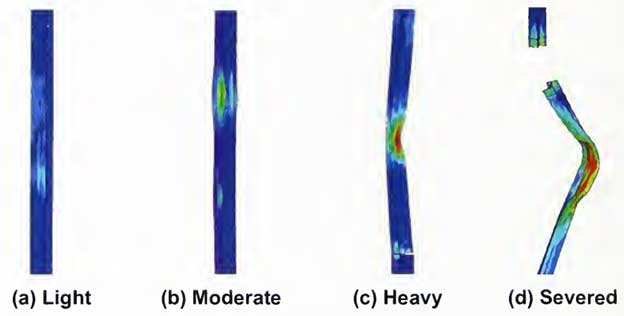
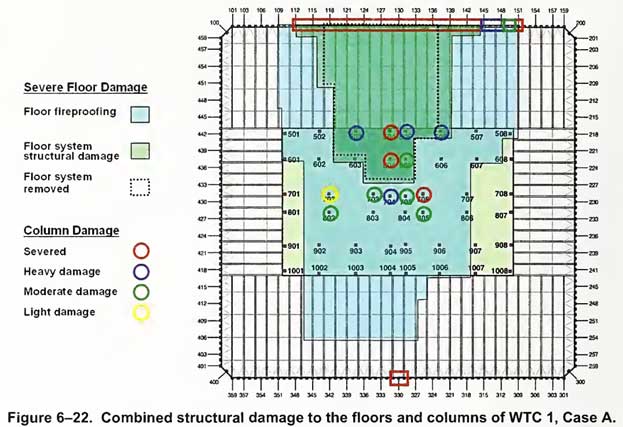
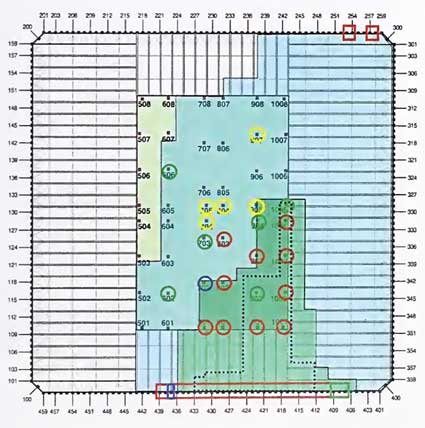
The fires would cause the columns within the core to deflect, bow, and bend. Each time this occurred, the load would be transferred to another column that was weakened; ultimately, a chain of such failures would occur. The failure of the core columns allowed the floors to begin to release in some places as well, causing impact loads in the form of the collapsing floors. As the core columns failed, the loads were transferred upward to the hat truss, and then to the perimeter columns as well as downward. There is no evidence that the steel was melted at all during the incident, as indicated by theorists, nor is there evidence of any internal malicious devices placed on the core columns (explosives). The core columns failed because of impact load and weakening secondary to fire load.
Failure of the Perimeter Columns
The perimeter columns of the WTC played a significant role in the load redistribution, column failure, and collapse of the two structures. Following impact load via airplane strike between the 93rd and 100th floors of the North Tower, 34 perimeter columns were completely severed, while four columns were heavily damaged, and two columns were moderately damaged (Figure 4). The wings of the aircraft fragmented upon impact, dispersing jet fuel on multiple floors. In the South Tower, the impact load via airplane entered through the south face of the building between the 78th to 85th floors. At least 29 perimeter columns were completely severed, one was heavily damaged, and three were moderately damaged. Four perimeter columns on the north wall also were severed as the landing gear and parts of the plane traveled explosively through the east portion of the building and out the other side.
One would expect the load to be concentrated on the now-gaping holes within the towers, but they were not. The loads on the perimeter columns that were destroyed were now redistributed upward to the hat truss, and then redistributed to the core and perimeter columns on the south side of the building in the North Tower, and on the east and north side of the South Tower. Every action or load has a reaction; the enormous loads were placed on other perimeter columns within the towers. As fires raged within the buildings on multiple floors, this placed more and more gravity loads upon the perimeter columns on opposite sides of the impact areas of the buildings. As the core and floor systems were weakened by fire, the floors began to sag and twist. We all know that heat causes steel to expand, but when a steel beam is restrained—in this case by the core and perimeter columns—the steel sags and twists. As this occurred, the perimeter columns supporting the loads began to pull and bow inward (Figure 5). As the perimeter columns failed, the loads were instantaneously transferred to the already weakened core, and a violent progressive collapse ensued as all systems failed simultaneously. As the perimeter columns failed in the North Tower, the building leaned inward toward the south and the subsequent perimeter columns could no longer support the loads leading to collapse. In the South Tower, the east walls were ravaged by fire. As the floor systems sagged, they pulled the east perimeter columns inward, initiating a progressive collapse.
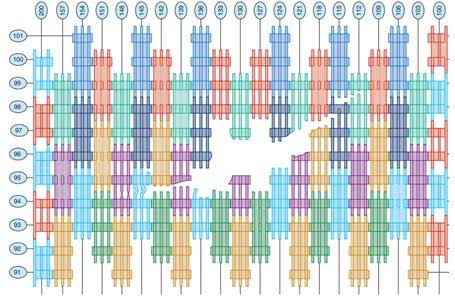
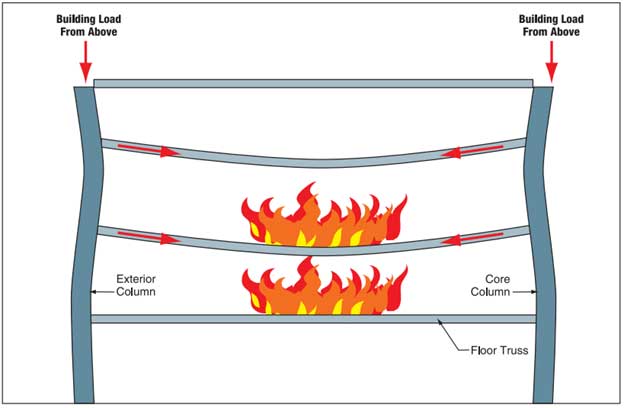
Failure of the Floor Systems
The floors were the weakest part of the buildings. In fact, there was no documented fire resistance testing done on these floor systems prior to installation. In addition, the 1968 NYC Building code allowed for less SFRM to be applied to the truss systems than the previous 1938 NYC Building code. A one-hour fire reduction rating was required, and the SFRM was only ½ inch on the lightweight floor systems. It wasn’t until June 2001 that the Port Authority required two inches of applied SFRM, which obviously did not happen before September. As the aircraft struck the towers, both sustained floor collapse on multiple floors throughout the impact areas. Each 40,000-square-foot floor had lost the majority of its SFRM via the explosion on the impact floors. As the fires raged within the buildings, the floors either released from their lightweight connections or sagged. As the floor systems failed, loads could no longer be transferred between the perimeter columns, core columns, and hat truss. In addition, as floors began to release from their connections, they produced significant impact loads to the floors beneath the impact area as they fell. The floor systems pulled the perimeter columns inward and precipitated the global collapse of the buildings.
The Hat Truss
Topping off both buildings between the 107th and 110th floors was a steel truss system called the hat truss (Figure 6). Its primary purpose had been to support a tall antenna atop each tower, although only WTC 1 had one installed. The hat truss provided additional connections among the core columns and between the core and perimeter columns, as well as additional means for load redistribution (NIST, 2005).
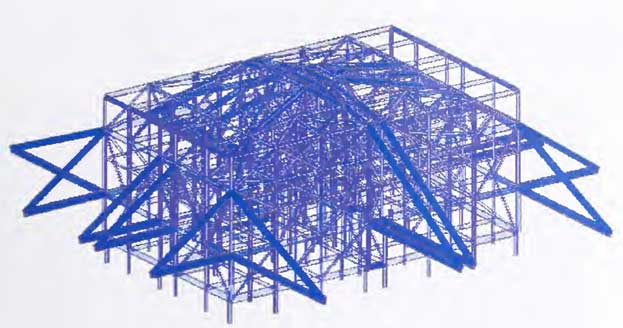
As the core and perimeter columns began to fail, the loads were transferred to the hat truss, which redistributed them further to the intact columns on the exterior walls and core. As the remaining columns sustained further damage from fire, significant loads were being transferred and the hat truss began to distribute more and more loading to certain portions of the building. As floors weakened, the perimeter columns bowed inward, the core columns were overloaded, and collapse ensued.
Contributing Factors
All the aforementioned failures fall under the umbrella of contributing factors, showing that there was no one cause outside of the initial attack. Another question often asked is why the South Tower fell first. It comes down to two factors: the acceleration of the collapse sequence because of greater damage done to the core columns, and loading. Because the building was hit in a different location, significant damage occurred within the core’s structural systems. Furthermore, let’s consider the loading. The North Tower was struck between the 93rd and 100th floors, with eight floors of structural compromise. The South Tower was struck between the 78th and 85th floors, at least six floors of structural compromise. Each floor of the towers weighed at least 2,000 tons each. In the case of the North Tower, the damaged structural systems below the impact area had to redistribute and carry a load of at least 20,000 tons. The South Tower had to carry the load of at least 54,000 tons. The more than double the weight of the load that needed to be carried by the damaged building, in addition to the damage to the core columns, was a significant factor that led to the South Tower collapsing so quickly. This goes for any building: as loads increase and surpass the load carrying capability of its structural systems, regardless of fire, collapse is imminent.
Another question often posed is why no survivors of the initial impact could escape the towers. There were three stairwells in the core of each building. In the North Tower, the building was struck on a side that allowed for complete impact to the long side of the core which obliterated the stairwells, standpipes, elevators, sprinkler risers, and smoke control systems. There was simply no way out or in. In the South Tower the damaged was focused on the southeast portion of the building. Two of the three stairwells were destroyed. Because stairwell “A” was remote from the impact and was not completely destroyed, 18 people above the impact area were able to escape. However, the elevators, standpipes, sprinkler risers, and smoke control systems were destroyed.
The events of September 11th, 2001, are etched into the minds of the entire world forever. The fire service and the Fire Department of New York (FDNY) in particular sustained heartbreaking and unbearable loss. Thousands of years of experience, and more importantly irreplaceable members of family units, were murdered by cowards who aimed to destroy the very fabric of a nation. But their attempt failed. The events of that day brought the country closer together and ignited a new passion in the fire service from every street in New York to the shores of the West Coast. The love of the fire service has been in some ways sustained and bolstered by the sacrifices of 343 men that day. The intent of this series was to continue the duty of every firefighter, which is to use previous jobs to teach other members and learn from tragedy. In the years it took to research this information, it has been my honor to pass it on in hopes of giving back just a small bit of information to even one firefighter.
This series is dedicated to the memory of FDNY Firefighter Adam D. Rand of Squad Company 288 and Chief Training Officer of the Bellmore Fire Department. (Figure 7) Adam responded with his company on 9/11 to the World Trade Center and was lost with his brothers during the collapse. I hope in some way these articles have made him proud.
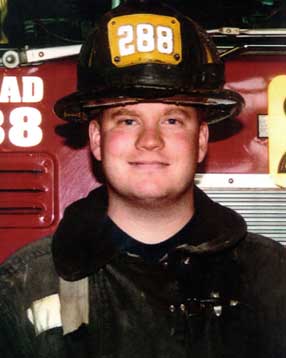

SALVATORE ANCONA is a deputy chief fire instructor at the Nassau County (NY) Fire Service Academy; a lieutenant with the Seaford (NY) Fire Department; a fire inspector with the North Bellmore (NY) Fire Department; a former captain and training officer for the Bellmore (NY) Fire Department; and a former paramedic supervisor in New York City. He has a bachelor’s degree in fire and emergency services administration from John Jay College of Criminal Justice, an A.S. degree in fire science from Nassau Community College, and is attending Georgetown University for his masters in Emergency & Disaster Management. Ancona is the author of the building construction page “The Sons of Brannigan” on Facebook and was a recipient of the 2019 FDIC International Honeywell DuPont Scholarship.

